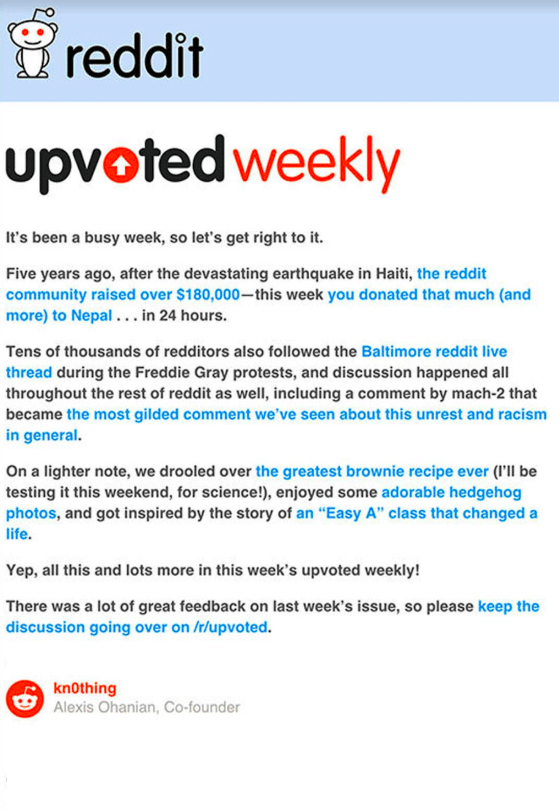What is a successful email marketing campaign made of? The answer: a whole lot of moving parts, processes, and workflows. To ensure success, you need to make sure each piece is managed well and that all of them fit together seamlessly. How do you do that? With an email marketing strategy template.
How to create an email marketing strategy from the ground up:
- Choose the right tools
- Identify your audience
- Build your list
- Create segments
- Identify goals and success metrics
The above steps will help you build a successful email marketing campaign. Plus, you can repeat these processes for continued success.
A recipe for success: 6 steps to build an email marketing strategy template
Each of these steps is essential for building an effective email marketing strategy.
1. Choose your weapons wisely.
Any email marketing strategy requires the right tools to help you create, send, track, and measure your marketing emails and campaigns.
First, you need an email service provider. This is the tool that will help you create, organize, and send your emails plus provide basic tracking. In addition to an ESP, you may want to go one step further and pick out some extra tools to make your life easier.
For instance, an automation tool helps you send marketing emails at strategic times, including those triggered based on a user’s web activity.
To find a good option, check out this post from Neil Patel on 23 marketing automation tools.
Once you have your go-to tools chosen, record them in a document for your team, including logins.
2. Identify your target audience.
Your target audience is the set of people who would make ideal customers. They’re the people who want your product, need your product, or have a problem you can solve.
Your email marketing should set out to attract them, interest them, and, ultimately, convert them into leads or buyers.
To find your target audience, think about a few major factors, according to Inc.:
- Who are your current customers?
- Who are your competition’s customers?
- Who will benefit from your product(s)/service(s)?
Once you hone in on all of these different groups, figure out where they overlap. Determine common demographic information like:
- Age
- Gender
- Location
- Occupation
- Income
- Education
- Marital status
You should also think about your target audience’s habits, personal traits, and attitudes. For example, what are their hobbies? What do they value in life? What are their shopping behaviors?
Once you know who you’re targeting with your email marketing, it’s much easier to tailor your messages and content to appeal to them.
After you figure out your target audience’s demographics, traits, and habits, record them for safekeeping in your email marketing strategy template.
3. Build your list of subscribers.
To build your email list of subscribers, you need to gather their email addresses. How do you do that? You need to attract them, build trust with them, and win them over so they want to hear more from you.
A few tactics for list-building include:
- Create relevant content with an ask attached – With content, you build trust by providing value to your audience. Educate, entertain, or inspire them. Then, somewhere in your content, include a call-to-action that asks them to sign up for your email list.
- Make a one-time offer – A free offer in exchange for an email address is a great way to build your list. Try offering a freebie like a tip sheet, template, or ebook and ask for their email before they can download it.
- Keep an opt-in form on your website – This is a tactic plenty of brands use. Often, the opt-in form is located in the sidebar or footer and is a static element. This gives your audience the chance to sign up at a moment’s notice while browsing your website. For instance, Etsy keeps an opt-in form in their footer. It appears at the bottom of every page:

4. Segment your list.
So far, you have one group of email subscribers who probably fall into your main target audience. Sending relevant emails to all these different people can get a little tough, especially as your list grows.
What’s the answer?
Email list segmentation.
This process involves splitting your list into smaller groups based on similarities. For example, if your target audience consists of men and women, ages 25-34, you could segment this larger group into two smaller groups: those in their twenties and those in their thirties.
Here’s a good example of a targeted newsletter from Reddit. It will appeal to people who love Reddit (“redditors”) and follow Reddit updates religiously:

Ideally, each of your list segments should have a different buyer persona attached. This is a profile of the ideal customer that represents the major traits of the entire group.
Coming up with email campaigns for each of your segments is a proven way to get better results. According to research by Aberdeen, email messages that are personalized this way get a 14% improvement in click-through rates and a 10% jump in conversions.
5. Create emails that mesh with your brand and audience.
You have all the background information necessary—now it’s time to create some emails.
First up, what kind of emails will you send? A weekly newsletter? Updates on your newest blog post? Emails triggered based on user interactions with your website?
For instance, Legacy Box created a drip campaign that sent out a series of emails about a sale on their site.

To help you figure out which types of emails to send, think about a few factors:
- Are there important days during the year where a drip campaign would help spread the word (think sales, events, conferences, holiday deals, etc.)?
- Do you publish content regularly, and would a newsletter help more subscribers see it?
- Do you have content ideas that would work well in email messages?
Include all of your email ideas in your email marketing strategy template.
6. Figure out your goals and how you will measure your campaign’s success.
You have your tools. You figured out your target audience and personas. You built up your email list. Now, it’s time to determine your goals for your email campaigns.
Think about what you want to achieve with your email marketing. A few common goals include:
- Building a larger email list
- Getting more opens for your emails
- Increasing your click-through rates
- Converting more loyal subscribers into buyers
You can have one or two overarching goals for each individual email campaign, or you can choose one or two for all of your email marketing endeavors. Remember: it’s totally dependent on your brand and business goals.
Wrap up
Email marketing is a process with lots of moving parts and pieces. Without a solid strategy in place, you’ll have a much harder time keeping track of it all, planning individual campaigns, and measuring your progress and success.
Create an email marketing strategy template you can use over and over again to help make everything simpler. You’ll streamline your efforts as well as create more effective, targeted campaigns that net real results.





